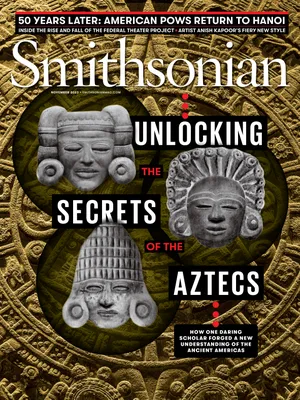The Precarious History of New York’s Iconic Chrysler Building
Towering ambitions built the most charming skyscraper in America
:focal(896x580:897x581)/https://tf-cmsv2-smithsonianmag-media.s3.amazonaws.com/filer_public/95/f0/95f0cbd0-15d3-4932-af51-d43e221f9af4/nov2023_c03_prologue.jpg)
On a mild October day in 1929, the architect William Van Alen watched from the corner of 42nd Street and 5th Avenue in Manhattan as a 185-foot steel needle rose from the guts of his unfinished masterpiece, the Chrysler Building. For months, New York media had breathlessly covered the battle between Van Alen and his former business partner, H. Craig Severance, to complete the city’s tallest building. Van Alen’s 27-ton spire, secretly assembled high up in the building’s skeleton, was his trump card. Hoisted into place in less than two hours, the spire brought the Chrysler’s height to 1,046 feet—handily beating Severance’s Manhattan Company Building.
But there was scarcely time for celebration. Plans had already been announced for the Empire State Building, which would shatter the Chrysler’s record just over a year later. More important, the morning after Van Alen’s coup, a calamitous stock market crash plunged the United States into the deepest economic crisis the country had known. With its eccentric steel helmet and grandiose lobby, a temple to the power of American industry, the Chrysler Building encapsulated the giddy excess of its time—an Art Deco exclamation point to mark the end of an optimistic decade.
Dominating the New York skyline brought prestige and publicity, but tall towers also resolved a more prosaic problem: As land prices climbed, developers had to build upward to turn a profit, pushing their projects as high as engineering, natural light and, eventually, zoning would allow. “Skyscrapers were a self-fulfilling prophecy of the heated real estate market,” writes Neal Bascomb in his 2003 book Higher: A Historic Race to the Sky and the Making of a City. By the 1920s, with Europe in ashes after World War I, these buildings became brash totems of a new world order. Manhattan in particular had become the “harbor of the world, messenger of the new land … of the gold diggers and of world conquest,” wrote the German architect Erich Mendelsohn in his seminal 1926 book Amerika, published the year after New York overtook London as the world’s most populous city.
/https://tf-cmsv2-smithsonianmag-media.s3.amazonaws.com/filer_public/01/70/01706bd2-980d-4ab6-9a2f-c616ee863009/nov2023_c07_prologue.jpg)
As the New York Times reported in May 1929, skyscrapers had “become to the whole of these United States a symbol, a fashion and a heaven-climbing contest.” Money seemed inexhaustible, and as speculation came to defy the laws of financial logic, buildings increasingly seemed to defy the laws of physics. When the market plunged, vacancies in New York soared; the Empire State Building, for instance, sat mostly empty for almost a decade. The Chrysler fared better, opening in 1930 with over 70 percent occupancy by companies including Western Union and, of course, Chrysler, whose founder, Walter Chrysler, had purchased the lease on the lot, and Van Alen’s design, before construction began. Even still, what one writer for Scientific American had, in 1930, called “a towering sword of fire” soon looked like a gaudy act of hubris. In a brutal 1931 takedown for the New Republic, the legendary critic Lewis Mumford dismissed the building as “a series of restless mistakes.” Moreover, he wrote, the Chrysler proved “the real dangers of a plutocracy: It gives the masters of our civilization an unusual opportunity to exhibit their barbarous egos.”
But ego alone was not enough to make projects at this scale work. After the Chrysler family sold the tower in 1953, the building went into four decades of decline, as successive owners cut maintenance costs, drilled lights into the lobby’s painted ceiling and used the spire to store junk. In the early 1970s, with New York City itself careening toward bankruptcy, the Chrysler’s occupancy rate reached a catastrophic low of 17 percent, and even after its 1978 inscription by the city’s Landmarks Preservation Commission, the building kept slipping further into disrepair. A $100 million renovation in the late 1990s resuscitated the building, but it has continued to change hands, most recently in 2019, as more desirable towers sprout up around it.
After the trauma of 9/11, pundits once again declared the age of the skyscraper over, but in the last two decades towers around the world have only gotten bigger. As Carol Willis, a historian and founder of New York’s Skyscraper Museum, notes in her 1995 book Form Follows Finance: Skyscrapers and Skylines in New York and Chicago, “The tallest buildings generally appear just before the end of a boom.” The Woolworth Building, the tallest building in the U.S. before the Chrysler, was completed a year before the outbreak of World War I, and the World Trade Center topped out in 1973 as an oil crisis sent the world economy into a tailspin. Today, Manhattan is home to five buildings taller than the destroyed Twin Towers. Who can say what will bring this latest boom to an end? Developments like these respond to economic context: The Chrysler Building’s spire did not puncture the stock market bubble; its mirror-like arches merely reflected it.
Surrounded by giants, the Chrysler Building today seems almost diminutive—yet perhaps no other New York building attracts such admiration. “The skyscraper is a romantic concept,” Willis says, and the Chrysler speaks to the romantic possibilities of the still-young nation. As Madeleine Ruthven wrote in a 1937 poem named for Van Alen’s crowning achievement, “These airy mountains of glass / Are the signature of an age — / A way of life that must pass.”
